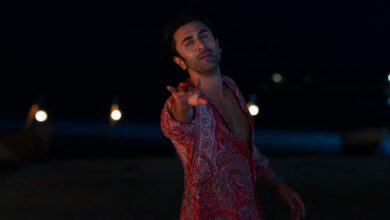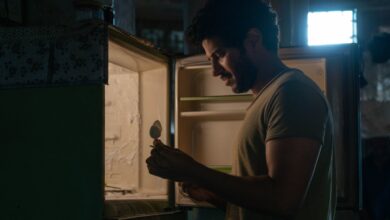ONE PIECE Film Red Review: The Pirates of Oda To The Sound Of Music, Between Action and Introspection
Cast: Mayumi Tanaka, Shuichi Ikeda, Kaori Nazuka, Kazuya Nakai, Akemi Okamura
Director: Gorō Taniguchi
Filmyhype.com Ratings: 3.5/5 (three and a half stars)
The stratospheric success of ONE PIECE Film Red in Japan depends on a series of factors. The anime based on Eiichiro Oda’s manga, to begin with, always attracts a gigantic audience, to say the least in the land of the Rising Sun, and beyond. It should also be added that the presence of Shanks the Red, who has always been one of the most enigmatic and loved characters and now finally returned to the centre of the manga’s plot, acted as a catalyst for most of the fans. Finally, the signature behind this feature film should not be underestimated: Goro Taniguchi, a talented director known above all for his work with the Sunrise studio and for having directed Code Geass: Lelouch of the Rebellion R2.

While waiting to understand how ONE PIECE Film Red will be welcomed by Italian audiences, we previewed the new film starring the Straw Hat Pirates, arriving in our cinemas on 1 December thanks to Anime Factory (it should be noted, however, that ONE PIECE Film Red will be released in original version with subtitles on 7 and 8 November). How is the adventure of Luffy and his inseparable companions designed for the big screen this time?
ONE PIECE Film Red Review: The Story
Shortly after the events narrated in the narrative arc of the country of Wa (Chapter 909; episode 892), the Straw Hat crew travels to the island of Elegia, once the world home of music, with the intent of witnessing a mega concert by singer Uta; Uta is the star of the moment, in the last 5 years she has become the idol par excellence, loved by everyone. The concert begins in a great way and the young singer delights her audience with sweet melodies, but at the end of the first song, with great surprise, our Luffy bursts onto the stage and begins to converse with the star; a few lines and the mystery is revealed. The girl is the daughter of the legendary Shanks the red and she has known Straw Hat since childhood.
The events at this point begin to blend in an exciting kaleidoscope of singing performances, spectacular brawls distinguished by a goliardic and colourful spirit and narrative flashbacks that reveal very interesting backstories. In any case, our Uta has eaten a very particular fruit of the devil: the Uta Uta, the fruit of the devil of the Paramisha type that allows you to transport people’s consciousness in a virtual space, all through singing. Uta wants to give life to an infinite concert, creating a new world and a new era, a utopian world away from war and suffering. A world therefore without pirates is considered by her as dangerous criminals, despite their kinship with one of the four emperors. At this point, Luffy and a sensational number of pirates, including many old glories, will join forces and try to stop the singer. As if that were not enough, the world government also intervenes, sending big bits to the island, from Kizaru to Issho.
For a series of narrative elements that we are not here to anticipate, to avoid ruining some surprises in case you are not yet on par with the main work, ONE PIECE Film Red is set after the arc of the Country of Wano. In any case, do not worry: the references to what happened in the manga are just mentioned in the course of the film, were it not for some premises and some characters that are taken for granted. Despite this, those who are not up to date on the latest developments shouldn’t have too much trouble understanding the whole narrative substrate, because Red tells an unedited story while adding some surprising fragments of Lore to the original mythology.
This should not come as a surprise: all the ONE PIECE feature films are just fillers aimed at delving into some background of the pirate world created by Oda. In this case, as many will have guessed, the revelations concern the emperor who many years ago gave Monkey D. Luffy the mythical straw hat: in fact, we discover that Shanks has a daughter, Uta, who as a child used to play with the little protagonist between a raid of the crew of the Red and the other, accompanying the band of Shanks and entertaining them with his splendid voice. However, one day, for reasons unknown to our protagonist, Uta disappeared from everyone’s life, abandoning her dreams of adventure and repudiating any link with her parents.
Luffy finds her many years later, profoundly changed in her spirit and ambitions: Uta is now a star known throughout the new world, infusing messages of peace and hope with her spectacular concerts. However, the girl developed a deep and visceral hatred towards pirates, which he accuses of having brought only fear and violence into the world. The confrontation between the singer and the Mugiwara captain, who finds himself involved in a battle between the young woman and other crews, is inevitable. And between one clash and another, between songs and prophecies, revelations about the true nature of Uta and the role of Shanks in the past of the same are made.
ONE PIECE Film Red Review and Analysis
ONE PIECE Film Red is a rather long film. In almost two hours of duration, the plot takes all the time necessary to create a mix of action, reflections and long flashbacks aimed at explaining in detail the past of the determined Uta. It must be said that it is precisely the script that does not fully convince. Compared to the latest cinematic incarnations of the franchise, Red tries to delve deeply into the psychology of its protagonists – especially as regards the unpublished characters – focusing on rather current issues. Uta embodies the figure and culture of idols, and both in her actions and in the reasons that move her, there is a not-too-veiled criticism of violence and social hysteria, but also of the force of words and the use of music as an instrument of universal peace.
Unfortunately, in this chaos of content and messages, the central segment of the film ends up becoming too confusing and full of different articulations, getting lost in long-winded dialogues and not effective editing. Even the use of music, through real pieces of singing, heavily weighs down the rhythm of the events, especially since after the first hour the plot begins to “talk to each other”, reiterating concepts and themes that perhaps would have needed more management dry. Fortunately, however, the film’s visual counterpart is of absolute value. ONE PIECE Film Red offers a graphic style completely in line with the excellent Stampede (find our review of ONE PIECE Stampede to find out more), and in general, it remains very close to the most recent artistic direction introduced in the television anime, far surpassing it in terms of the quality of the stroke and animations.

Exquisitely fluid sequences and breathtaking clashes highlight a technical component of very high thickness and alternate with a never-invasive CGI mostly used to animate the incredibly realistic dances of Uta – a character who, net of the perplexities about writing, convinces and will make fans fall in love by Eiichiro Oda. The flagship is certainly the design, not only for the style with which the characters are outlined but above all as regards the outfits: in full Oda style, the clothes and bright colours flaunted by the imposing cast of the film fascinate and seem straight out of the manga, an element that will surely make all the admirers of the paperwork happy. Of great originality, however, are the musical battles derived from the power of Uta, a sound and visual element that gives freshness and novelty to the active component of ONE PIECE. Up to, then, a final clash that to define as overflowing with fanservice could even diminish the scope of what was staged by Taniguchi’s staff.
Previously we have reported some numbers related to the sensational success of the film in question. Success is not entirely by chance, but the result of long-researched work. However, the film presents a mix of aspects that managed to capture the viewer’s attention, prompting him to invade cinemas. One of the biggest pieces of news is the introduction of the character of Uta who on paper has all the potential to become a canonical character. In this regard, the well-known account newwordartur specializes in the world of One Piece, has practically confirmed the presence of Uta in chapter 1055. Uta is also a singer with a crystalline talent and here the film for long stretches becomes a full-blown musical, another absolute novelty.
However one of the main reasons for the film is the presence of the legendary Shanks the red. In the film, through spot-on flashbacks, we will discover new aspects of his past while in the finale we will see him at work in a lightning-fast sequence that shows all his power and charisma; pirate feared by all, including the very strong admirals of the Navy. Finally, many iconic characters appear during the film, seen on different occasions: Kobi, Trafalgar Law, Blueno, Bartolomeo, Helmeppo and Bepo. Last but not least important aspect is the director Gorō Taniguchi. Taniguchi has made several cults like Gun X Sword, s-CRY-ed, and Code Geass: Lelouch of the Rebellion, not to mention his maximum masterpiece Planetes. Such a director cannot fail to capture the interest of the enthusiast.
One Piece Film Red is a very atypical product, the musical part is conspicuous and full of meanings. The singing sequences are many and present a multifaceted directorial style. In some situations, the director resorts to tricks typical of the docu-films of famous concerts: jump-cut, connotative editing, sinuous and circular camera movements, panoramic views of the raving crowd or close-up details of the singing star are the practice. Very interesting than the situations in which Uta in addition to singing realizes realistic ballets. Here comes a perfect CGI, such as to make those segments a sort of digital dance essay, worthy of the best video artists.
There are also fights to the sound of musical notes; certainly, we are not at the levels of a Doctor Strange in the Multiverse of Madness, with an ending that then turns towards psychedelic dimensions with light horror shades where red, green and blue take over everything. Action at times is incessant, perhaps too much, and there are not a few moments that are a bit confusing and caciaroni also saw the numerous cast; let’s say that the time is a bit excessive. Fights interspersed with interesting diegetic flashbacks, are also useful for dosing and slowing down the crazy pace imposed by the director. Among the many fights, we point out a riot with archaic stone robots that emit laser beams. The director is very attached to the mecha universe and, if he can, he never misses an opportunity to remind us of it.
Uta is certainly the undisputed protagonist of the film and through her character, the director carries out a series of reflections related to contemporaneity. The girl exploded in a very short time, after a series of virtual performances. The virtual world that has granted her incredible popularity, all hangs from her words, but at the same time, a kind of loneliness and general malaise emerges. Not surprisingly, when he realizes his first life he would no longer wants to detach himself, materially, from his audience. Here another theme also comes into play; in reality, the world built by the girl is all fictional, a sort of dream in which to hide from her real problems. Here the director, despite a very commercial and at times superficial imprinting, recalls great masters such as Satoshi Kon (Paprika) or Mamoru Oshii (Lum – Beautiful Dreamer).
ONE PIECE Film Red Review: The Last Words
In conclusion, ONE PIECE Film Red is a good film by the standards of Eiichiro Oda’s pirate work, but perhaps a step back from the engaging and rhythmic Stampede. While recounting very topical issues and messages of great importance, the screenplay is lost in the central phase, all too verbose and full of musical moments that end up becoming cloying. Defects that are however well balanced by the directorial and visual counterpart, offer truly spectacular and memorable moments and battles. Finally, we find a strong pacifist theme; Uta, although she is somehow corrupted by her fame (which materializes in the form of a demon), still has the desire to build a peaceful and war-free world.







